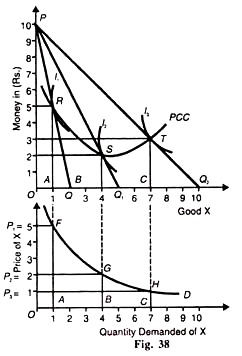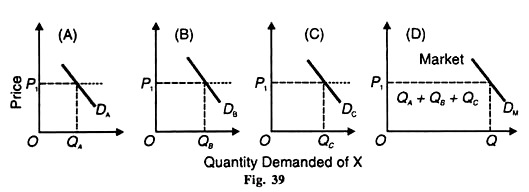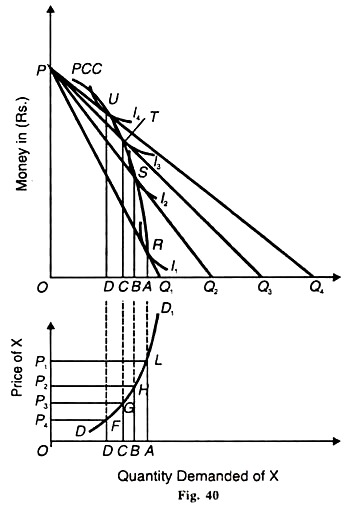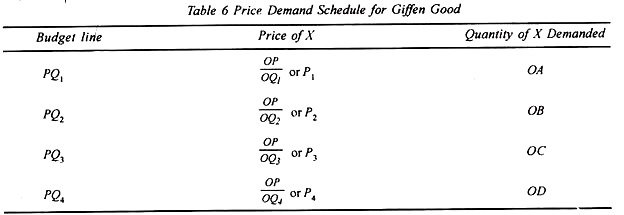This article will guide you about how to derive demand curve from price-consumption curve.
Introduction:
The price-consumption curve (PCC) indicates the various amounts of a commodity bought by a consumer when its price changes. The Marshallian demand curve also shows the different amounts of a good demanded by the consumer at various prices, other things remaining the same.
Given the consumer’s money income and his indifference map, it is possible to draw his demand curve for any commodity from the PCC.
The conventional demand curve is easy to draw from a given price demand schedule for a commodity, whereas the drawing of a demand curve from the PCC is somewhat complicated. But the latter methods has an edge over the former. It arrives at the same results without making the dubious assumptions of measurability of utility and constant marginal utility of money.
ADVERTISEMENTS:
The derivation of demand curve from the PCC also explains the income and substitution effects of a given fall or rise in the price of a good which the Marshallian demand curve fails to explain. Thus the ordinal technique of deriving a demand curve is better than the Marshallian method.
Assumptions:
This analysis assumes that:
(a) The money to be spent by consumer is given and constant. It is Rs 10.
(b) The price of good X falls.
ADVERTISEMENTS:
(c) Prices of other related goods do not change.
(d) Consumer’s tastes and preferences remain constant.
If in the double story Figure 38, money is taken on the vertical axis in rupees and good X on the horizontal axis. PQ, PQ1 and PQ2 are the budget lines of the consumer on which R, S and T are the equilibrium positions forming the PCC curve.
He buys OA, OB and OC unit of X respectively at these points on the PCC curve. If the total money income of the consumer is divided by the number of goods to be bought with it, we get per unit price of the good. For OA unit of X, he pays OP/OQ price; for OB units, OP/OQ1 price; and for OC units, OP/OQ2 .This is, in fact, the consumer’s price-demand schedule for good X which is shown in Table 5.
The price-demand schedule of the consumer for good X shows that given his money income OP (Rs.10) when he spends his income in buying OQ quantity (2 units), it means that the price of X is OP/OQ (Rs.5) as per budget line PQ at which the consumer buys OA (one unit) of good X. This is shown by point R on the f curve.
When the price of good A” as determined by the budget line PQ, is OP/OQ, (Rs. 2), the price-consumption curve shows that he buys OB (4 units) of X. This is shown by point S on the curve I2. When the price of good X is determined as OP/OQ2 (=Re 1) on the budget line PQ2 and the curve L at point T, the consumer buys OC (7 units) of X. Point R, S and T on the PCC curve show price-quantity relationships for good X.
These points are plotted on the lower diagram in figure 38. The price of X is taken on the vertical axis and quantity demanded on the horizontal axis. To draw the demand curve from the PCC, draw a perpendicular on the lower figure from point R in the upper portion of Figure 38 which should pass through point A. Then draw a line for point P1 (=5) on the price axis (lower figure) which should cut the perpendicular at point F.
The points G and H are drawn in a similar fashion. They are joined by a line to form the demand curve D. This curve shows the amount of X demanded by the consumer at various prices. With the fall in the price of X the consumer buys more units of it and the demand curve D slopes downward to the right.
The Market Demand Curve:
If the demand curves of a number of individuals are derived from this price – consumption curve for a good and then added together we get the market demand curve for that good. Thus in Figure 39 (A) the demand for good X at the price OP1 is QA on the part of consumer A.
ADVERTISEMENTS:
Consumer В demands QB of X at the same price and С consumer Qc as shown in Panels (B) and (C). These quantities QA + QB + QC are added sideways in Panel (D), where the slope of the demand curves of all the individuals and hence for the market is the same.
Like the individual demand curve, the market demand curve will slope downward to the right, shown as DM in Panel (D) of the figure. It will not, however, slope to the left even if the good happens to be inferior for some individuals.
There will be other consumers demanding it at a lower price to which it may not appear an inferior good. For the market as a whole, a good is not likely to be inferior at all, there being always a sufficient number of buyers over the same price range. Hence the market demand curve will always slope downward to the right.
Positively Sloping Demand Curve:
The downward slope of the demand curve from left to right is for ordinary goods, as is shown in the lower portion of Figure 40. But if X happens to be a Giffen good, the demand curve slopes upwards to the right. It is positively sloping. X being a Giffen good when its price falls, the real income of the consumer increases. As a result, he spends his income on superior goods and buys less quantity of the Giffen good X.
ADVERTISEMENTS:
The demand curve for a Giffen good has been drawn from the PCC in Figure 40. In the upper portion of Figure 40, the backward sloping PCC curve for the Giffen good X is drawn.
The consumer is in equilibrium at point R on the budget line PQ1 With the successive fall in the price of X, he moves to points S, T, U on the budget line PQ2, PQ3 and PQ4, and buys lesser quantities OB, ОС and OD of X respectively The following price demand schedule (Table 15.6) is drawn from the PCC curve.
ADVERTISEMENTS:
This schedule is depicted in the lower portion of Figure 40 Point L is the locus of price-quantity relationship when OA quantity of X is demanded at OP1 price. Similarly, points H, G and F are drawn. When we join these points the demand curve DD1 is formed which slopes upward to the right showing a direct relationship between price and quantity demanded.
When the price is P1, the amount demanded is OA. Since X is a Giffen good, as its price falls to P2 the consumer buys less than before. He buys OB quantity of X. As price falls further to P3 and P4 he buys lesser and lesser quantities ОС and OD of X respectively. Thus the positively sloping demand curve DD1 for the Giffen good X shows that with the fall in its price, quantity demanded decreases, and vice versa.




